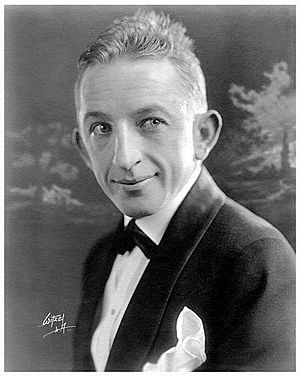Larry Semon facts for kids
Quick facts for kids
Larry Semon
|
|
|---|---|

Semon, c. 1922
|
|
| Born |
Lawrence Semon
February 9, 1889 West Point, Mississippi, United States
|
| Died | October 8, 1928 (aged 39) |
| Other names | Lawrence Semon, Zigoto, Ridolini, Jaimito, Tomasín |
| Occupation |
|
| Years active | 1916–1928 |
| Spouse(s) |
Lucille Carlisle
(m. 1922; div. 1923)Dorothy Dwan
(m. 1925–1928) |
| Children | 1 |
Larry Semon (born February 9, 1889 – died October 8, 1928) was a famous American actor, director, and writer from the silent film era. Silent films are movies without spoken dialogue. Larry Semon was a big comedy star in his time.
He is mostly remembered today for working with Stan Laurel and Oliver Hardy. This was before Laurel and Hardy became a famous comedy duo themselves. Semon also directed and starred in a 1925 silent movie called The Wizard of Oz. This film had a small impact on the more famous 1939 Wizard of Oz movie.
Contents
Early Life and Beginnings
Larry Semon was born in West Point, Mississippi. His father, Zera Semon, was a traveling magician known as "Zera the Great." His mother, Irene Semon, helped in his father's magic act. Larry and his older sister joined their parents' show when they were young.
After finishing school in Savannah, Georgia, Semon moved to New York City. There, he worked as a cartoonist and graphic artist for newspapers. While drawing, he also performed comedy acts in vaudeville shows. Vaudeville was a popular type of stage entertainment. His performances caught the eye of Vitagraph Studios, a movie company. In 1915, they offered him a contract to work in films.
Comedy Career in Silent Films
When Semon joined Vitagraph, he first worked behind the scenes. He wrote stories, directed, and produced films for another actor, Hughie Mack. Sometimes, Semon would play small parts in these movies. When Hughie Mack left, Semon started playing the main roles.
He often played a silly character with a white face, a derby hat, and overalls. This character would usually cause a lot of trouble and chaos wherever he went. Imagine a bakery, a restaurant, or a construction site turning into a mess because of him! His short slapstick comedies were made very quickly. Slapstick comedy uses exaggerated physical actions for humor. This made Semon very well-known to movie fans.
As Semon became more famous, his films grew longer. They went from about 12 minutes to twice that length. He was given a lot of freedom in making his movies. Semon was known for making very expensive films. His two-reel comedies sometimes cost more than longer feature films.
Because he used to be a cartoonist, Semon loved to create cartoon-like stunts. He didn't use special camera tricks. Instead, he used huge, real props and structures. No stunt was too big for him! He enjoyed chase scenes with airplanes, exploding barns, and falling water towers. He also loved using messy substances to cover people. For example, his films often featured barrels of flour, sacks of soot, or pools of mud. In one film, The Bell Hop, a man sleeping under a leaky fountain falls through the floor into a vat of paint!
Larry Semon also spent a lot of money in his personal life. He traveled often. To try and solve his money problems, he started making longer feature films. One of these was the 1925 Wizard of Oz, which sadly lost a lot of money. By 1927, he was back to making short films. After facing money troubles, Semon returned to performing in vaudeville shows. While touring, he became very ill and went back to Los Angeles.
Later Years and Death
After returning to Los Angeles, Larry Semon was taken to a hospital in Victorville, California. He passed away on October 8, 1928, at the age of 39. He died from pneumonia and tuberculosis. His wife, Dorothy Dwan, was with him when he died.
Other Names for Larry Semon
Larry Semon was known by different names in other countries:
- In France, people called him Zigoto.
- In Italy, he was known as Ridolini.
- In Spain, he was called Jaimito (meaning "Jimmy") in older films. Later, in the 1940s, he was called Tomasín (meaning "Tommy").
Filmography
Larry Semon directed and starred in many short comedy films during his career.
Images for kids
See also
 In Spanish: Larry Semon para niños
In Spanish: Larry Semon para niños


